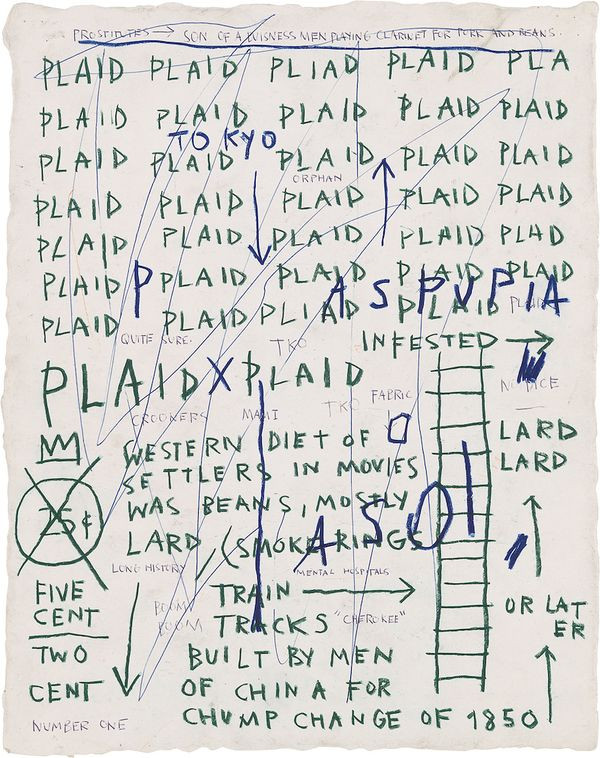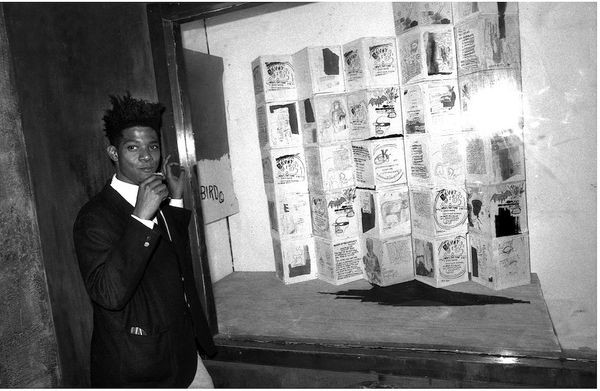Jean-Michel Basquiat, a prodigious talent of the 1980s New York art scene, famously declared that his art revolved around “royalty, heroism, and the streets.” His 1982 masterpiece, Untitled (Pestus), vividly captures this powerful triad. This pivotal work, created during Basquiat’s breakthrough year, offers a profound exploration of his artistic intentions and his deep connection to the urban landscape that shaped his vision.
Decoding Untitled (Pestus): Urban Vernacular and Street Roots
Untitled (Pestus) plunges us directly into Basquiat’s street-centric world. The painting’s upper register is dominated by “PESTUS” hovering above a stark black housing project. Words like “ASPHALT,” “SULPHATES,” and “BALTIC AVE” are strewn across the canvas, grounding the artwork in a distinctly urban reality. Basquiat’s art was born from the streets of New York City, where his career began as SAMO, a graffiti artist. This piece reflects that raw, unfiltered energy of the streets, the very asphalt he walked, and the often-harsh realities of the urban environment. This raw portrayal of the streets isn’t just a backdrop; it’s the foundation of Basquiat’s artistic language.
Royalty and Heroism in the Everyday: Basquiat’s Upward Trajectory
Within this streetwise context, Basquiat subtly weaves in themes of royalty and heroism. Arrows and wave-like symbols suggest an upward movement, a visual metaphor for rising from the bottom up. This ascent can be interpreted on multiple levels – linguistic, iconographic, and social. Basquiat elevates the everyday experiences of street life, imbuing them with a heroic quality. He finds royalty not in crowns and palaces, but in the resilience and spirit of the streets, transforming the mundane into something powerful and significant. His journey from street artist to gallery darling is itself a heroic narrative, reflecting this upward trajectory.
 Jean-Michel Basquiat's Untitled (Plaid) 1982, showcasing his early style and urban themes
Jean-Michel Basquiat's Untitled (Plaid) 1982, showcasing his early style and urban themes
A Breakthrough Year: Pestus and Basquiat’s Ascent
1982 was a turning point for Basquiat. Before this year, he was primarily known for his SAMO graffiti in the Lower East Side, a period where he and Al Diaz used public spaces to voice anti-establishment messages concerning race, identity, and consumerism. These concerns remain palpable in Untitled (Pestus), evident in its engagement with urban poverty, mass commodities, and neglected infrastructure in low-income communities. However, 1982 also marked the beginning of his mainstream recognition. Just prior to creating Pestus, Basquiat participated in the influential New York/New Wave exhibition at MoMA PS1 in 1981, alongside art world luminaries like Keith Haring and Andy Warhol. This exposure, coupled with Annina Nosei’s gallery support, propelled him from street icon to gallery sensation. Untitled (Pestus) stands as a testament to this pivotal moment, capturing the raw energy of his street art roots alongside his burgeoning confidence as a celebrated artist.
Duality and Displacement: Symbolism in Pestus
Untitled (Pestus) is rich in symbolism, revealing Basquiat’s ongoing exploration of duality and displacement. The stark contrast between the bare background and the loose, figurative signs is striking. While the painting evokes the sensory overload of bustling New York streets through vibrant colors and words, it also incorporates geographically distant references like “CARRIBEAN SUGAR” and “HAITIAN BASEBALL (IMPORTED).” This thematic fragmentation mirrors Basquiat’s own life, navigating a dual cultural heritage from his Haitian and Puerto Rican parents, and his complex identity as both a subversive street artist and a rising star in the elite art world. This duality, this push and pull between different worlds, is at the heart of Untitled (Pestus) and much of Basquiat’s compelling oeuvre.
 Black and white portrait of Jean-Michel Basquiat in his studio window in 1985
Black and white portrait of Jean-Michel Basquiat in his studio window in 1985
In Untitled (Pestus), Basquiat masterfully synthesizes his defining themes of royalty, heroism, and the streets. He transforms the gritty reality of urban life into a space of both struggle and triumph, celebrating the heroes of the everyday and finding a unique form of royalty within the vibrant chaos of the streets. This painting is not just a snapshot of 1982 New York; it’s a timeless exploration of identity, ascent, and the powerful artistic voice that emerged from the streets to conquer the art world.

